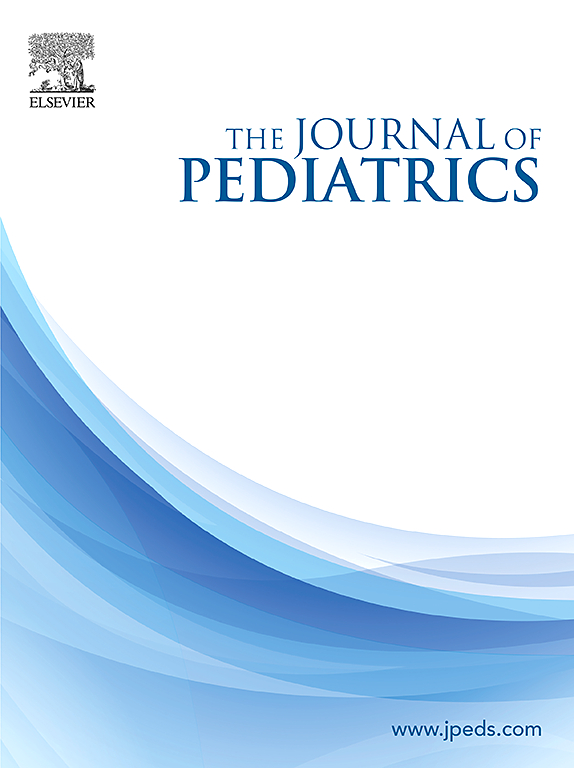商业保险儿童流感并发症高危人群抗病毒药物使用的相关因素
IF 3.9
2区 医学
Q1 PEDIATRICS
引用次数: 0
摘要
目的:评估美国流感高危并发症儿童抗病毒药物的使用情况,并确定与配药相关的因素。研究设计:我们使用Merative MarketScan商业声明和Encounter数据库对2016-2020年流感季节18岁以下个体的门诊就诊进行了回顾性队列研究。高危状态是根据美国传染病学会的定义定义的,包括:年龄、特定合并症、妊娠或产后状态、居住在长期护理机构。主要结局是在流感诊断后两天内分配抗病毒药物(奥司他韦、扎那米韦、巴洛韦)。我们使用改良泊松回归确定与抗病毒配药相关的临床因素。结果:在331,389名流感并发症高风险儿童中,共发现372,372例流感发作,并纳入本研究。年龄中位数(四分位数间距)为4.0岁(2.0岁,9.0岁)。总体而言,在201,638例(54.1%)流感发作期间,进行了抗病毒治疗。与抗病毒药物使用增加相关的因素包括哮喘、美国西部和南部地理区域、紧急护理环境和特定的健康保险计划。与抗病毒药物使用减少相关的因素包括年龄更小、急诊科环境、中西部和东北部地理区域以及健康保险计划。结论:尽管国家指南建议所有流感并发症高危儿童接受抗病毒治疗,但在我们的研究中,近一半的高危儿童没有接受抗病毒治疗。我们确定了与抗病毒治疗减少相关的几个因素,这些因素可能有助于为未来的干预措施提供信息,旨在改善对流感易感儿童的护理。本文章由计算机程序翻译,如有差异,请以英文原文为准。
Factors Associated with Antiviral Drug Use Among Commercially Insured Children at High Risk for Complications of Influenza
Objectives
To evaluate the prevalence of antiviral drug use in children in the US with influenza at high risk for complications and to identify factors associated with dispensing.
Study design
We conducted a retrospective cohort study of outpatient visits for individuals < 18 years during the 2016-2020 influenza seasons using the Merative MarketScan Commercial Claims and Encounter database. High-risk status was defined using Infectious Disease Society of America definitions and included: age, specific comorbidities, pregnancy or postpartum status, and living in a long-term care facility. The primary outcome was antiviral (oseltamivir, zanamivir, baloxavir) dispensing within 2 days of influenza diagnosis. We determined clinical factors associated with antiviral dispensing using modified Poisson regression.
Results
A total of 372 372 influenza episodes were identified among 331 389 children at high risk for influenza complications and included in this study. The median (IQR) age was 4.0 years (2.0, 9.0). Overall, during 201 638 (54.1%) episodes of the influenza, antiviral treatment was dispensed. Factors associated with increased antiviral use included asthma, West and South US geographic regions, urgent care settings, and specific health insurance plans. Factors associated with decreased antiviral use include younger age, emergency department setting, Midwest and Northeast geographic regions, and health insurance plans.
Conclusion
Despite national guidelines recommending that all children at high risk for influenza complications receive antiviral treatment, nearly half of these children at high-risk did not receive an antiviral in our study. We identify several factors associated with decreased antiviral treatment that may serve to inform future interventions aiming to improve the care of vulnerable children with influenza.
求助全文
通过发布文献求助,成功后即可免费获取论文全文。
去求助
来源期刊

Journal of Pediatrics
医学-小儿科
CiteScore
6.00
自引率
2.00%
发文量
696
审稿时长
31 days
期刊介绍:
The Journal of Pediatrics is an international peer-reviewed journal that advances pediatric research and serves as a practical guide for pediatricians who manage health and diagnose and treat disorders in infants, children, and adolescents. The Journal publishes original work based on standards of excellence and expert review. The Journal seeks to publish high quality original articles that are immediately applicable to practice (basic science, translational research, evidence-based medicine), brief clinical and laboratory case reports, medical progress, expert commentary, grand rounds, insightful editorials, “classic” physical examinations, and novel insights into clinical and academic pediatric medicine related to every aspect of child health. Published monthly since 1932, The Journal of Pediatrics continues to promote the latest developments in pediatric medicine, child health, policy, and advocacy.
Topics covered in The Journal of Pediatrics include, but are not limited to:
General Pediatrics
Pediatric Subspecialties
Adolescent Medicine
Allergy and Immunology
Cardiology
Critical Care Medicine
Developmental-Behavioral Medicine
Endocrinology
Gastroenterology
Hematology-Oncology
Infectious Diseases
Neonatal-Perinatal Medicine
Nephrology
Neurology
Emergency Medicine
Pulmonology
Rheumatology
Genetics
Ethics
Health Service Research
Pediatric Hospitalist Medicine.
 求助内容:
求助内容: 应助结果提醒方式:
应助结果提醒方式:


